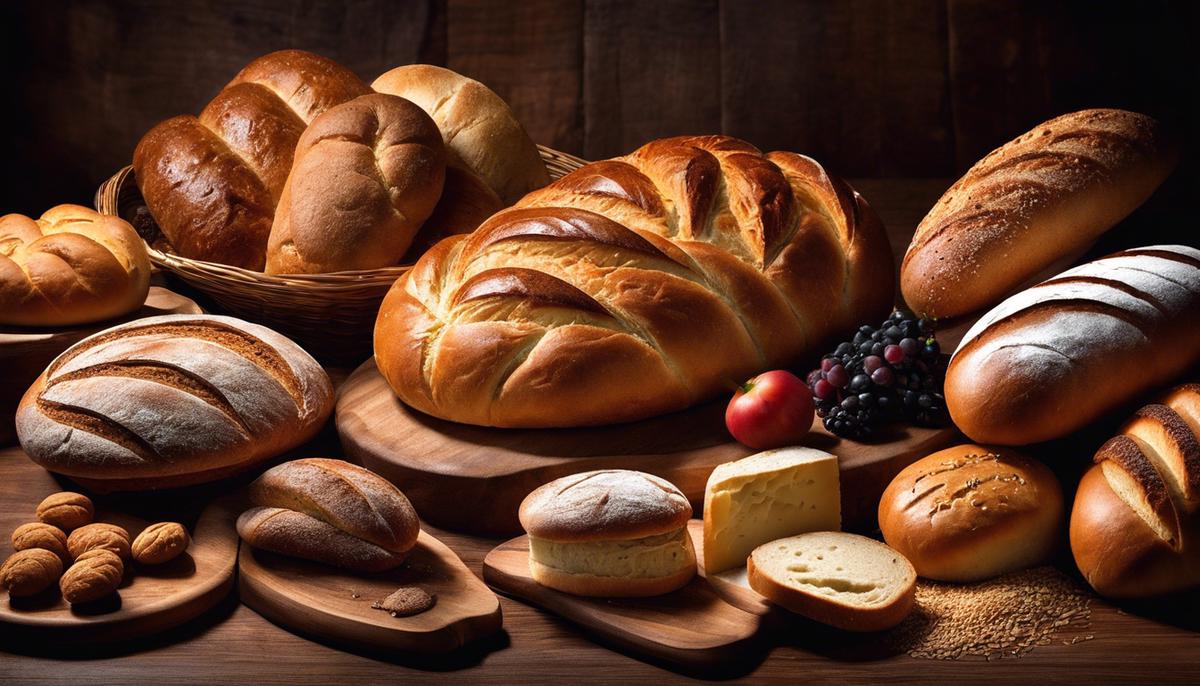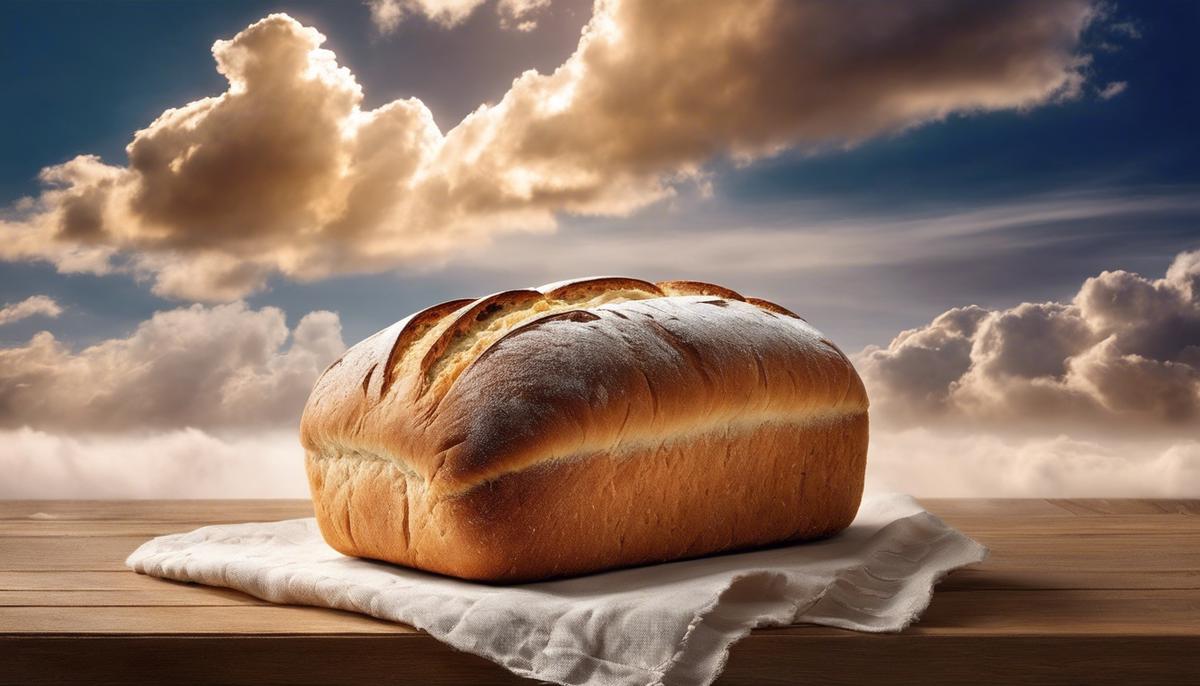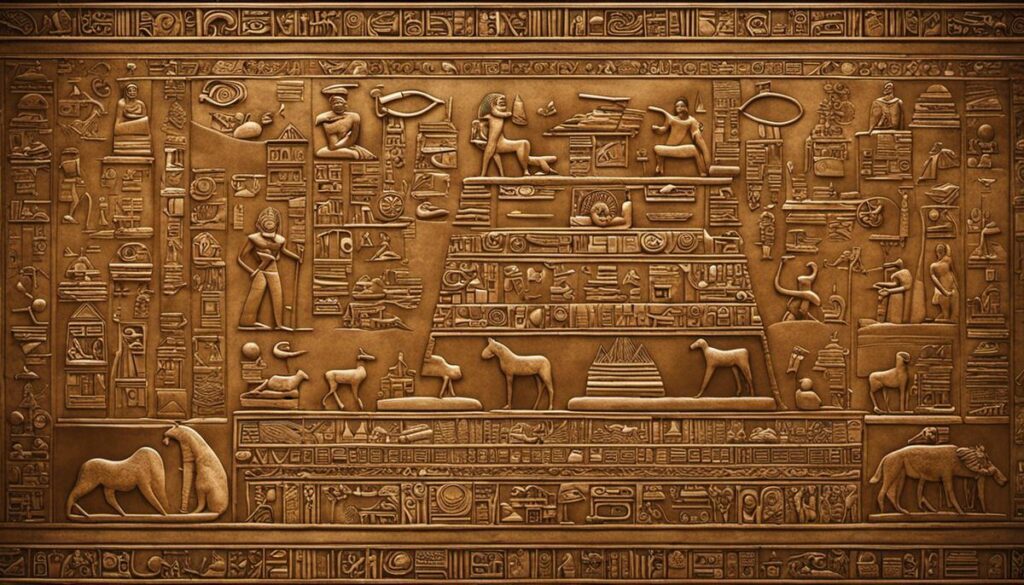Since the dawn of human cognition, dreams have remained an evocative and fascinating enigma. Predominantly, dreams have posited philosophical conundrums that modern science is still attempting to decipher. This essay penetratingly journeys into the captivating universe of dreams and explores the symbolism of one of its recurring elements – bread. Delving into a broad space of theoretical frameworks, from Sigmund Freud’s psychoanalytic dream proposition to Carl Jung’s profound symbol interpretations, and progressing to contemporary cognitive theories, this exploration seeks to set the cornerstone for in-depth comprehension of dream symbols. It hones its focus on the symbolism of bread within the dreamscape, a seemingly mundane yet significantly universal archetype, extending its implications towards individual and collective subconscious narratives as influenced by personal experiences, societal identities, and cultural backdrops.
Theoretical Background of Dream Analysis
Foundational Theories of Dream Interpretation: An In-depth Study
Dreams have intrigued humans since time immemorial, leading to various hypotheses and theories being proposed so as to provide an interpretation of these intriguing experiences. This article caters to the exploration and elucidation of these foundational theories revolving around the elusive theme of dream interpretation.
The first theory demanding attention is Sigmund Freud’s psychoanalytic theory of dreams, rooted in his established principles of psychoanalysis. For Freud, dreams represented the royal road to the unconscious mind, a channel for communicating unfulfilled wishes and desires. His seminal publication, “The Interpretation of Dreams,” published in 1899, posits that dreams are a complex web of coded desires and messages, a veiled fulfillment of unacceptable wishes that often relate to childhood experiences and innate drives.
In contrast to Freud’s emphasis on latent content and wish fulfillment, Carl Jung proposed a broader perspective. Jung’s theory of dreams sees them as gateways to collective unconsciousness. He suggested that dreams are not just about repressed desires but a valuable tool to apprehend profound universal symbols or ‘archetypes,’ which play a crucial role in personal growth and self-realization.
The activation-synthesis hypothesis fostered by Hobson & McCarley in 1977, posits a neurological angle on dream interpretation. According to this theory, dreams are nothing but the brain’s attempt to make sense of random neural firings occurring during the REM sleep. This model contrasts with the more psychologically rooted theories of Freud and Jung, highlighting the disconnection between the dreamer and the external world.
Moving towards a more cognitive focus, the Information Processing Theory proposed by Cartwright in 2010 suggests dreams serve as an adaptive function to help process emotional experiences. Here, dreams are seen as the mind’s attempt to organize and integrate experiences into memory, aiding in resolving daily concerns and emotional distress.
Antti Revonsuo’s Threat Simulation Theory (2000) lends an evolutionary perspective to dream interpretation. According to Revonsuo, the primary function of dreaming is the rehearsal of threatening situations, to enhance threat-avoidance skills and survival mechanisms.
The Neurocognitive Theory, propagated by Domhoff, suggests dreams are a form of organized cognition that are independent of waking thought but influenced by personal biases, concerns, and emotions. It connects cognitive science with neurobiology, presenting dreams as a byproduct of mental processes, pertinent to both waking and sleeping states.
It’s evident that dream interpretation has been approached from multifaceted angles throughout history. While some theories pin importance on the psychological content, others bring attention to the neurological or cognitive processes underlying dreams. Despite the diversity, an overarching theme connecting the theories portrays dreams as a complex interaction between cognitive processes and subjective experiences, facilitating a deeper understanding of oneself and the surroundings. The realm of dream interpretation, encased in ambiguity, continues to serve as a promising field of research, pushing the boundaries of human understanding towards the enigmatic and unknown.

Bread as a Universal Symbol in Dreams
The Cultural Semiotics of Bread in Dream Symbolism
Unraveling the symbolism of bread within the scope of collective consciousness necessitates an exploration into the far reaches of cross-cultural dream interpretations, which in turn reveals a vast array of societal representations and mythopoeic underpinnings. From ancient civilizations to modern society, the symbol of bread often acts as a conduit to decode a range of themes, from success and abundance to hunger and deprivation.
Commencing our discourse with the Mesopotamians, one of the earliest civilizations, reveals the symbol of bread fundamentally communicated sustenance, representing an existential necessity. The same trope carries forth into the biblically centered cultures, where bread commonly symbolizes life, divine provision, and spiritual sustenance in dreams. For instance, in the Christian tradition, “bread” not only fulfills a literal need but evolves into a spiritual exemplification in the form of the Eucharist, symbolizing the body of Christ.
On the other end of the spectrum, in Asian cultures, specifically within Chinese dream interpretations, bread assumes a dichotomous symbol. Witnessing bread in dreams can signify both economic profit and the potential of bad luck or illness, hence accentuating the complex relation between bread and life experiences.
In The Islamic tradition, the vision of bread in dreams deals with themes of fertility, prosperity, and divine benevolence. More significantly, dreaming about bread could signify an individual’s quest for knowledge in Islamic cultures, alluding somewhat to the old proverbial phrase that “knowledge is the bread of life.”
Simultaneously, Indigenous cultures and tribal societies, like Native Americans, exemplify the bread as a symbol of community and cohesion as it represents shared meals, unity, and communal prosperity in dream contexts.
To dissect the symbolism of bread in dreams from an African perspective, the dream of bread takes on a heuristic approach to understand life’s challenges. It commonly implicates scarcity or forewarns the dreamer about looming hardship, thus emphasizing the realistic and consequential impact of dreams in their cultural context.
In sharp contrast, within the realm of Slavic cultures and dream symbology, a dream about bread might hint at potential conflicts, disagreements, or discords, underlining the societal emphasis on harmony and tranquility.
The symbolism of bread in dreams encapsulates a mosaic of meanings and interpretations grounded in diverse cultural landscapes. These perspectives ultimately highlight our collective wealth of knowledge and nuances, reflecting our unique societal interpretations while basking in the awe-inspiring realm of shared human consciousness. The symbolism, in this context, transcends the simple means to satisfy a basic physiological need and transforms into a sophisticated tool for interpreting psychological, existential, and even mystical facets of human existence. Therefore, in the grand contexts of dream interpretation and cultural semiotics, the simple representation of bread acquires profound dimensions, donning the garb of complex socio-cultural, economic, and spiritual metaphors.

Contextual Interpretations: The Role of Personal and Societal Factors in Bread Dream Interpretation
As we delve further into our exploration, a detailed understanding of the subtleties enveloping contemporary dream interpretation theories and their underpinning societal factors is indispensable, particularly regarding symbolic ones, like bread. Anthropologists, psychologists, and cultural theorists have underscored that personal experiences, societal norms, cultural practices, and religious ideologies significantly impact the interpretation of such symbols in dreams.
One such stream is cultural relativism, flowing from Franz Boas’s research, asserting that symbolic interpretations vary across cultures and societies, reflecting diverse socio-cultural practices and perspectives. For example, while considered universally as a sustenance symbol, different cultures attach unique interpretations to bread dreams. In a capitalist or market-oriented society, dreaming of bread may be related to fears or desires concerning economic stability. Meanwhile, in agrarian societies, dreaming of bread may indicate the season’s productivity or potential crop failures, considering their dependence on farming for livelihoods.
The Contextual Theory of dreams, introduced by renowned psychologist Calvin S. Hall, emphasizes the role of individual life circumstances in dream interpretations. Applying this theory, a struggling entrepreneur dreaming of a bread may interpret it as a reflection of their aspiration for financial stability, while a fitness enthusiast may view such a dream as a struggle with dietary restrictions.
The anthropological study of dreams presents another intriguing facet. The Cognitive Theory of Cultural Meaning postulates that dream symbols, including bread, are interpreted based on the individual’s collective societal memories. For example, a society undergoing a famine would associate dreams of bread with scarcity and hope, while a historically war-inflicted society might link the absence of bread in dreams with peace and prosperity.
In a similar vein, the dominantly psychological Cognitive-Experiential Self Theory of personality by Seymour Epstein proposes a direct link between one’s emotional and cognitive experiences and dream interpretations. Amid an economic crisis, for instance, a middle-class individual might view a bread dream through a survival lens, while an affluent person might overlook its symbolic significance.
Hence, an amalgamation of personal experiences, societal norms, and cultural practices shape the interpretation of dreams about bread, pointing towards a larger, intricate interplay between internal psychological processes and external socio-cultural dynamics. This fascinating discourse highlights the rich tapestry behind the seemingly mundane symbol of bread in dreams, underscoring the integral role of cultural context and personal experiences in dream interpretation while enriching our understanding of human consciousness.

The understanding of dreams and their intricate symbolism is akin to unlocking a deeply personal cognitive diary, one that is colored by layers of individual experiences and societal narratives. Dreams of bread, an elemental human necessity, lend themselves to a rich tapestry of interpretations, from associations of survival and sustenance to signals of wealth and prosperity. The types and forms of bread enhance the complexity of these representations, binding them succinctly with the dreamer’s unique circumstances, cultural ethos, and economic climate. As with other dream motifs, the interpretation of bread stands as a testament to the deeply connected web of human experience mirroring in dreams; they are nodes of connection bridging the everyday reality with the unexplored recesses of our minds. By unravelling these links, we gain access to a deeper understanding of our hopes, fears, desires, and constructs that ultimately shape the fabric of our existence.








